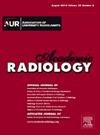Patient Engagement with Radiology Report Content: A Retrospective Analysis of 60,572 Radiology Report Views
IF 3.8
2区 医学
Q1 RADIOLOGY, NUCLEAR MEDICINE & MEDICAL IMAGING
引用次数: 0
Abstract
Rationale and Objectives
To evaluate patient use of plain language radiology report content.
Methods
Webpage-style radiology reports delivering patient-centered content were made available to patients via an online patient portal. Simple language explanations of terms and phrases in the reports were accessible to patients via a clickable hyperlink. For each viewed radiology report over a one-year study period, we recorded a count of the individual terms and phrases in the report that were annotated (i.e., had accessible patient-centered content), the annotated terms and phrases that the patient clicked, and the number of clicks of each term. The terms were categorized according to the hierarchical RadLex Tree Browser.
Results
In 60,572 unique viewed reports, there were 380,798 term clicks out of 4264,663 annotated terms (overall click rate 8.9%). 878 terms were annotated ≥ 1000 times. The click rate varied between these high-frequency terms from 0.1% to 63.2%. The average term click rate varied between RadLex categories from 16.7% for clinical findings to 7.9% for the property category.
Discussion
Modern web technologies can be used to gain insight into patient experience viewing online radiology reports. There is a significant variance in patient use of patient-centered radiology report content.
患者对放射报告内容的参与:60572个放射报告视图的回顾性分析。
理由和目的:评价患者使用平语放射学报告的内容。方法:通过在线患者门户网站向患者提供以患者为中心的网页式放射学报告。患者可以通过可点击的超链接访问报告中术语和短语的简单语言解释。在为期一年的研究期间,我们记录了报告中被注释的单个术语和短语的计数(即,具有可访问的以患者为中心的内容),患者点击的注释术语和短语,以及每个术语的点击次数。根据分层RadLex树浏览器对这些术语进行分类。结果:在60,572个独立查看报告中,在4264,663个注释术语中,有380,798个术语点击(总点击率为8.9%)。878项标注≥1000次。这些高频词的点击率从0.1%到63.2%不等。RadLex分类的平均点击率从临床发现的16.7%到财产分类的7.9%不等。讨论:现代网络技术可用于了解查看在线放射学报告的患者体验。患者对以患者为中心的放射学报告内容的使用存在显著差异。
本文章由计算机程序翻译,如有差异,请以英文原文为准。
求助全文
约1分钟内获得全文
求助全文
来源期刊

Academic Radiology
医学-核医学
CiteScore
7.60
自引率
10.40%
发文量
432
审稿时长
18 days
期刊介绍:
Academic Radiology publishes original reports of clinical and laboratory investigations in diagnostic imaging, the diagnostic use of radioactive isotopes, computed tomography, positron emission tomography, magnetic resonance imaging, ultrasound, digital subtraction angiography, image-guided interventions and related techniques. It also includes brief technical reports describing original observations, techniques, and instrumental developments; state-of-the-art reports on clinical issues, new technology and other topics of current medical importance; meta-analyses; scientific studies and opinions on radiologic education; and letters to the Editor.
 求助内容:
求助内容: 应助结果提醒方式:
应助结果提醒方式:


